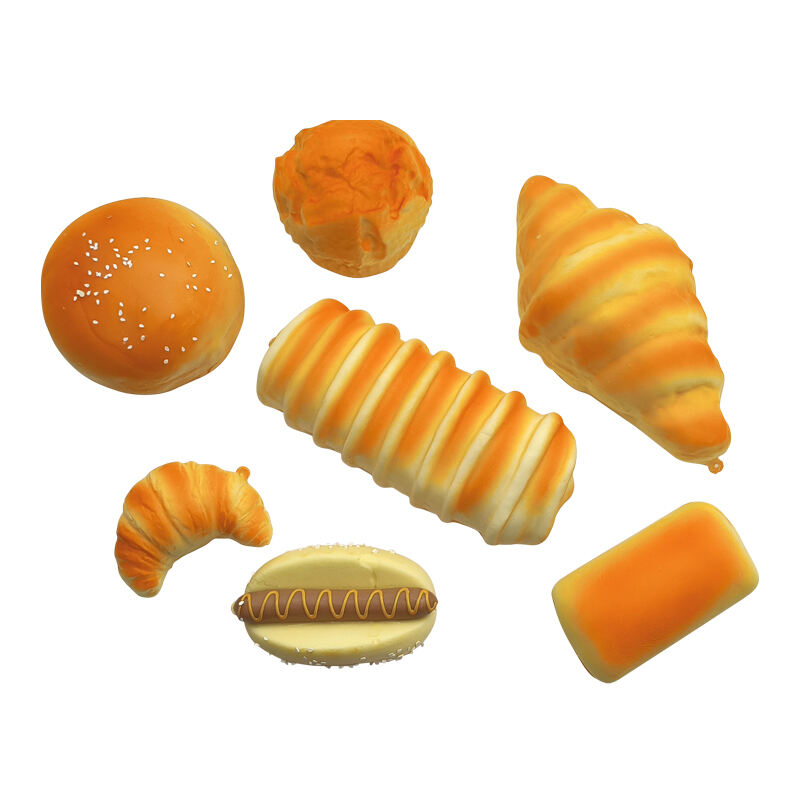Veçoritë Kryesore të Lojërave Sensory për Zhvillim të Parë
Diversiteti i Teksturës dhe Trajnimi Taktil
Ka shumë tekstura rrethueshër në këto lojra sensorike nga Hoovy me lloje të ndryshme të teksturave, dhe ky top ka të ngjashëm të jetë një opsion i parapëlqyer për të stimuluar ndjenjën e thirrjes së vajt. Rrjedhat tregojnë se veprime të takuara stimulojnë mbylljet e nervave në barkin e fëmijës, që është përfshirësisht e përsosur për të promovuar zhvillimin e trurit. Për shembull, ato lojtra mund të kanë sipas dhe haps, e lehtë dhe të gjermafaqe, duke lejuar fëmijëve të përmirësojnë aftësitë motorike të tyre të vogla ndërkohë që të mbështeten eksplorimi. Rrjedhat tregojnë se luajtja e takuar lidhet me ndërtimin e koordinimit të dorës me syt dhe me aftësi të larg. Kështu që, kaq edhe arsyeja pse është e nevojshme për prindër të zgjedhin vetem më të mirat, dhe më të mira për zhvillimin e ndjenjës së vajt të fëmijëve tuaj me material të sigurt, pa toksine, që stimulojnë me teksturë por asnjëherë nuk e rrezikojnë shendyrën e fëmijës tuaj. Një prej lojtarëve të tillë është mochiitoys, të cilat jetojnë në të gjitha lloje të teksturave dhe vargje të ndryshme të presjes, duke u bërë në një lojër ideale për largimin e stresit.
Larg dhe Largore
Efektet vizuale dhe të zemrave në lojërket sensorike janë çdoherë qëndror për t'u bërthyer fokusimi i fëmijëve dhe për t'u ndjeshur zhvillimi i trurit. Stili larg e ngjyrave dhe format e ndryshme stimulojnë fokusimin e shihur të fëmijëve, që mund ta larg jeshin duke luajtur për kohë të gjatë. Me veprime të aktivizueshme zemër si kaq shoq dhe muzikë e lehtë, ne ndihmojmë bebet të eksplorojnë aftësitë e tyre zemërake ndërkohë që mësojnë dhe rriten. Ka qenë vërtetuar se lojërka që lidhen me të gjitha elementet e jashtme sensorike janë suksesuese në ndërtimin e lidhjeve kognitivë, dhe përditës janë shumë të ndihmuara në zhvillimin e trurit gjatë vitet të parë të jetës. Lojërka me tekstura të ndryshme, zemra dhe dritë gjithnjë në një kanë impakt të madh sensorik në bebin tuaj të vogël. Shtimin e komponenteve si lojërka mochi që ofrojnë imazhe të ngjyra dhe zemra të përshtatshme mund të rritë kohën e luajtjes dhe të ndjeshë aftësitë kognitive të hershme.
Normat e Sigurisë dhe Larg dhe Larg
Nëse lojërory me stimulim sensorik do të ofrojnë vlerë të gjatë termi, duhet të jenë bërë nga materiale të fortë për të rënë nëpërmjet luajtjes aktivë të fëmijëve. Është e rëndësishme të sigurohet që lojërory janë në pajtim me rregullat ASTM & CPSC për të mbrojtur fëmijët nga kjemikalë të rrezikshme. Prindërët duhet të sigurojnë që lojërory me stimulim sensorik janë larg nga kjemikalë të dëmtuara si BPA dhe ftalatat. Rrjedhje të kërkimeve tregon se materiale jo toksike ndihmojnë për zonat më të sigurt luajshmëri duke minimizuar rreziket e komponenteve të dëmtuara. Një konstrukcion i mirë përfshin edhe të sigurojë që lojërory nuk shkatërrohen, dhe e shmangjen „larg” të rrezikshme kur luajnë me këtë lloj lojërory! Zgjedhja e lojëroryve të sigurta dhe të besueshme është e rëndësishme për të promovuar një eksperiencë luajshmërie të larg dhe të sigurt. Invesitimi në lojërory si disa prekje të befushme për fëmijë që plotësojnë këto kritikë mund të ofrojnë fëmijëve eksperiencë luajshmërie të sigura dhe të lumtur.
Kategoritë Më Popullore të Lojtrave Sensorike për Fëmij dhe Fëmijet
Lojtra Mochi Squishy për Hyrje Sensorike Larg
Larg dhe larg, lojtarët mochi squishy janë bëkur të preferuar të fëmijëve kur vjen në fjale lindja e dorëve tyre të paqartura nga puna, largimi i stresit dhe anksietet. Këto lojtarë ofrojnë një hyrje sinore e ruanesishme që mund të përfitojnë fëmijët ndërkohë që punejnë për të larguar energjinë eksces dhe të përmirësojnë fokusin. Larg dhe larg, i bëra në disa dizajne më të kena dhe lep të luajnë, një mochi squishy ofron fëmijëve një mjet të ri për të luajtur dhe të harruar. Kërkimi ka treguar gjithashtu se luajtja sinore, përfshirë edhe sqisjen, mund të zvogëlojë anksietetin në fëmijë. Pra, këto lojtarë janë popullarë ndaj prindërve. Lojtarri mochi Squishy është ashtu i vogël që është i lëndshëm për përdorim në shtëpi, në mashinë apo për kohë të presjes (e lehtë për të mbajtur me ju përgjithmon), si p.sh. gjatë udhëtimit, në ndaljen e autobusit apo në dhomën e presjes.
Lojtra për Larg për Praktikën e Larg dhe Skilleve Motorike të Vogla
Kjo nuk do të përmirësoj vetëm gjerimin me dorë, por mund të përdoret edhe efikas për zhvillimin e shkallës në fëmijë të larg. Përpara luajtjes me këto lojshje, fëmijët mund të lejojnë dhe të përmirësojnë aftësitë e dorës-dytë. Lojshjet për shprngulje jetojnë në të gjitha lloje formash dhe dizajne për të bërthuar dorë të vogla. Është interesant që nëse një fëmij i praktikon aftësitë motorike të vegjël dhe shkrimin në moshën e erdhe, kjo ka një efekt pozitiv në aftësitë e tyre për shkrim më vonë. Prindërët duhet të zgjedhin lojshje të pajisura për shprngulje që janë sigurta për të hulumtura, ofrojnjë opsion të mire për një lojër të mrekullshme dhe të kujdesishme.
Lojtoje për Larg dhe Larg me Përsyshjen e Shumë Sensorike
Përgjigje ndaj disa deformimeve, fëmijët kanë nevojë për objekte të tilla si këto lojëra që të mund të lëvizin, dhe lojërat mund të ndryshojnë gjendjen e tyre emocionale. Pra, kur lojërat me dhëmbë përdoren për tu shtypur, lojërat do të ndryshojnë në ngjyra të ndryshme. Funksioni i vonimit të syrit të dreqit në bazën e lojërave për lehtësimin e stresit na jep durimin dhe faljen e njerëzve. Kur fëmijët janë të brengosur, të rriturit mund t'i mësojnë ata të përdorin këto lojëra për të lehtësuar stresin ose për të shprehur ndjenjat e tyre. Lojërat për lehtësimin e stresit mund të ndryshojnë ngjyrë dhe kjo ngjyrë është më e mundshme të tërheqë vëmendjen e fëmijëve dhe ushtrimi kryhet në atë moment. Funksioni i bazës së ndryshimit me vonim të syrit të tigrit në lojërat për lehtësimin e stresit mund të vendosë energjinë negative të nesh. Më tej, funksioni i syve me ndryshim kohe është gjithashtu një mjet terapeutik efektiv për ne. Për këtë arsye, shumë lojëra për fëmijët autistë kanë tekstura, tinguj dhe pamje që angazhojnë disa sensorë për të dhënë një përvojë të plotë të kuptimit. Studimet kanë treguar se mund të ndihmojë në përmirësimin e rregullimit emocional dhe të ofrojë komfort fëmijëve që po lundrojnë nëpër ndjenja të tyre ose që ballafaqohen me situata të mëdha. Këto lojëra zakonisht janë mjaft të padukshme, prandaj prindërit mund t'i përdorin ato edhe në klasë, por pa tërhequr shumë vëmendje. Kur bëhet fjalë për zgjedhjen e zgjidhjeve më të mira për lehtësimin e stresit tek fëmijët e tyre, prindërit tentojnë të kërkojnë lojëra që janë shumë efektive dhe të shumëllojshme.
Ndjenca dhe Larg dhe Emocionet nga Lojja Sensorike
Zbërthimi i Lidhjeve Neuronale Përmes Eplorimit Taktile
Lloji i lojërave sensorike luaj rënd të madh në zhvillim të trurit dhe lëngimi i lidhjeve neuronike. Studimet shkencore konfirmon se eksplorimi taktil iq ka një rol kryesor në mësimin e fëmijëve, sepse i ndihmon ato të rregullojnë zhvillimin e tyre emocional dhe kognitiv. Nese një larg pasi përmban tekstura të ndryshme apo një fëmij është duke u përpjekur të gjejë si të punoj me lojërën e saj sensorike, si p.sh. lojërët mochi squishy, kjo e ndjen urat e problemeve dhe krijon hartë kognitive në trur. Specialistët rekomandojnë përdorimin e lojërave sensorike si pjesë e rutinës sotme, sepse kjo stimulim regjular do të mbështesë baza më të mirë për zhvillimin e trurit.
Mbështetja e Auto-Regjistrimit dhe Zhvillimit të Fokusit
Produktet sensorike janë të përdorshme për të ndihmuar fëmijët të largohen vetvet dhe të kontrolojnë problemet sensorike. Studimet kanë gjetur një lidhje në mes lojërimit sensorik dhe fokusit të përmirësuar në mësimtarë të vogla, duke provuar se aktivitetet si këto mund të ndjenë qëndrimin e vërtetë, dhe të rrisin aftësinë e fëmijëve të mendojnë për mënyrën se si mendojnë dhe ndjekin. Dy terapeutë psikologjikë ndajnë gjithashtu se shpallje të vegjël sensorike gjatë mësimit mund të ndihmojnë me fokusimin e tanishëm, dhe aftësitë e regjulimit të vet të mësuar në lojërime sensorike mund të kalojnë në zonat tjera, promovonte njohuri emocionale më të mira.
Ndërtimi i aftësive sociale përmes eksperiencave të përbashketa të lojës
Lloja e ndjeshme është një mjet i mirë për të bërthyer komunikimin dhe aftësitë sociale mes shokve. Kur fëmijët luajnë përgjithshëm me lojëra sensorike, ata mësojnë si të bashkangjitur, të negocionojnë dhe të ndryshojnë rradhë — cilat janë elementet kryesore për një interakcion social sukses. Kërkimi ka treguar se kjo lloj social kontribuon në aftësinë emocionale të fëmijëve në moshën e 3 deri në 5 vjeç. Përmirësimi, pjesa e prindërve në lojën sensorike mund të rritë munditë për lidhje dyfishtë, ndërsa grupe sociale që fokusojnë në aktivitete sensorike përmirësojnë aftësitë sociale dhe ndihmojnë fëmijët të formojnë lidhje sociale me shoqërat e tyre.
Zgjedhja e Mjeteve të Stimulimit Sensorik të Përshtatshme për Mosht
Kujdes për Siguri në Fazat e Largimit (0-12 muaj)
Është e rëndësishme që siguria të jetë paraküshtrimi i parë nëpër zgjedhjen e lojtarive sensorike për fëmijet, sepse fëmijët e larg dhe ndjeshem kanë tendencën të ndreqin gjithçka në gojën e tyre ndërkohë që eksplorojnë botën. Ata duhet të jenë bërth me materiale të sigurt për gojë, si p.sh. stofë e madhe ose silikon, për të siguruar se nuk do ta thirren dëndje gismit të fëmijëve dhe janë të sigurt përgjithësi. Do të donit të shmangni lojtarit me pjesë të veglël që mund të bëhen rrezik për sufimit. Larg nga kjo, studimat theksnojnë rëndësinë e 'dorimit' ndaj fëmijeve si një veprim rregullor gjatë zhvillimit. Prindjet duhet regjullisht të kontrollojnë lojtarit për shenja të zbritjes apo degjuar dhe të anasjellin ato që mund të krijojnë rrezik për këtë zonë të themelore të mësimit dhe të ndikimit.
Lojë Pushtetuese Por Larg dhe Të Ardhshme për Fëmij (1-3 vjeç)
Llojet e lojtarive për fëmijet larg vajza duhet të jenë të pafatshme dhe të ndezura që të mbajnë kujtesën e tyre, dhe në mënyrë ideale të përshtaten me juvet e tyre ndërkohësisht që zhvillohen. Këto lojtarive do të stimulojnë eksplorimin dhe kreativitetin, duke u përshtatur kur një fëmij është i thelluar me aftësi të reja. Është e bukur të keni lojtarive me atribut të ndryshme për të zbatim dhe të mbajtë kujtesën e tyre. Studimet tregojnë se lojërimi i çështjeve të ndezura por të qashta shkon përpara zhvillimit të aftësive mençore dhe fizike të fëmijve larg vajzave. Pra, kur vjen fjala për kompleksin e një lojtare, çelësi është të gjeni balancën e përtatshme ku ata mbahen interesuar por jo frustruar. Zgjedhur me kujdes që të lejojnë fëmijet larg vajzave të mësojnë ndërkohësisht që luajnë, kjo kohe lojërake promovon marra e tyre zhvillimore.

